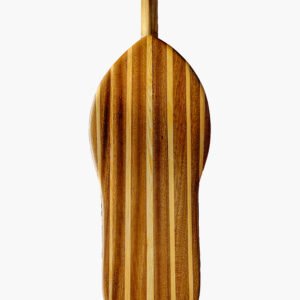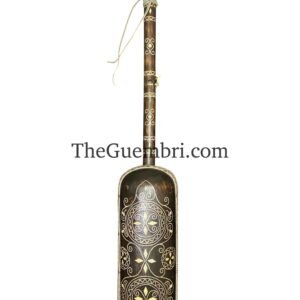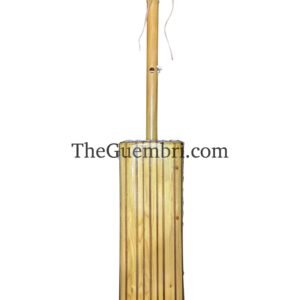Guembri
The Guembri is a plucked string instrument with a body carved from a single piece of wood and covered with camel or goat skin. It is a traditional instrument made by hand in an impeccable way that produces an atypical musical sound.
-
Sold out!

Guembri Excellence: Sapele and Spruce Harmonic Duo
Original price was: €350.00.€200.00Current price is: €200.00. -
Sold out!

Guembri : Crafted to Perfection in Sapele and Spruce
Original price was: €350.00.€200.00Current price is: €200.00. -
Sold out!

Guembri : Elegance in Ebony and Cedar
Original price was: €300.00.€210.00Current price is: €210.00. -
Sale!

Gumebri instrument – Harmony in Mahogany and Juniper
Original price was: €750.00.€250.00Current price is: €250.00. -
Sold out!

Black Guembri with Cow Bone Decoration
Original price was: €700.00.€320.00Current price is: €320.00. -

Brown Moroccan Berber Loutar
€170.00 -

Loutar price
€130.00 -

Guembri Electric Instrument
€20.00 -

Guembri Strings
€15.00 -
Sold out!

Guembri Instrument Medium Size
Original price was: €300.00.€190.00Current price is: €190.00. -
Sold out!

Medium Guembri decorated with cow bone
Original price was: €300.00.€190.00Current price is: €190.00. -
Sold out!

Guembri medium size decorated
Original price was: €300.00.€190.00Current price is: €190.00. -
Sold out!

Medium Guembri Special Edition
Original price was: €390.00.€190.00Current price is: €190.00. -

Guembri medium orange wood
€180.00 -

Guembri decorated with orange wood
€400.00 -
Sold out!

Guembri large instrument
€190.00 -

Guembri Exclusive Instrument
€410.00 -
Sold out!

Guembri wooden instrument Walnut Mahogany
€800.00 -
Sold out!

Vintage Guembri Gnawa instrument
€180.00 -
Sold out!

Classic Moroccan Guembri
€250.00 -
Sold out!

Special Guembri instrument
€900.00 -

Medium Classic Moroccan Guembri
€190.00 -
Sold out!

Guembri Instrument Gnawa Price Cost
€380.00 -
Sale!

Guembri for sale
Original price was: €800.00.€290.00Current price is: €290.00. -
Sold out!

Buy guembri Instrument
€900.00


The traditional musical instrument known as the Guembri consists of a large, carefully carved wooden box. It is hollowed out and polished with a camel skin. This is stretched and nailed to the wooden part which serves as the sound box of the Guembri. Above the sound box, a hole is dug in which a cylindrical pole is inserted, which rests inside the body of the instrument. On the other side of the camel skin, another hole is cut to allow for a scape sound.
The Guembri has three strings woven from goat intestine and resin. A first rope is attached to one end of the pole which coincides with the skin hole. On the other end, the second rope is firmly attached to the mast so as to throw a system of adjusting pegs. Finally, the third rope, which is usually the middle one, is meticulously integrated with an adjusting pet. So as to fit between half the distance between the end of the mast and the beginning of the soundboard. This gives it a higher pitch.
The professionalism of the design of the instruments from The Guembri
We put a particular emphasis on the quality of our creations in order to consolidate a relationship of trust with our customers who give us the pride of place through positive reviews and comments. We produce Guembri musical instruments that differ from each other in design and sound. To achieve this, we rely on a good selection of materials that guarantee an optimal sound quality.
Our various teams of professionals use innovation to transform this authentic vintage Moroccan geumbri, made by hand, into a true spiritual musical instrument made of high quality wood and leather. Our Guembri instruments are designed by professional Moroccan Gnawa artists renowned for their exceptional craftsmanship. They combine qualities of patience, passion and precision in the making of each instrument to ensure a good grip and smooth playability.
Provenance or origin of the Guembri
The Guembri, also known as Gembri, Gambri, Guember, Gumbri or Genbri is a traditional musical instrument. It is an instrument that comes from the Gnaoua people who are descendants of Guinean slaves. It is found mainly in North Africa in Morocco and Mali. The Guembri is a plucked string instrument also played by the Tuaregs and Berbers. It is a derivative of the African n’goni.
The Guembri is an instrument mainly used by the Gnawa who are North Africans with ancestry in sub-Saharan Africa. It seems to derive from lutes that are covered with similar skins from the Mali region or other parts of the Sahel.
Description of the musical sound of the Guembri
The Guembri is approximately the same size as a guitar with a body carved from a log and covered with camel skin. The camel skin serves the same acoustic function as the membrane of a banjo. The neck of the Guembri is a simple stick with a short string and two long goat strings that produce a percussive sound similar to a pizzicato cello or double bass. The goat gut strings are plucked downwards so that the index finger and the inside of the thumb join at the side. The wooden body of the Guembri, which is in the form of a hollowed-out canoe, makes a percussive sound and creates phalanges that strike the upper camel neck of the body while the thumb and forefinger pluck the strings. The lowest string is a drone note and the second string, the highest in pitch, is tuned an octave higher and is never fretted. The third string is tuned a fourth above the drone. The hum often heard emanating from the sintir is caused by metal rings that hang from a galvanised metal feather mounted at the end of the sintir’s neck. The feather and rings vibrate to the rhythm of the sintir.
The long neck of the instrument passes through the upper body and under the face, emerging through the skin near the base of the instrument. It serves as a tailpiece or string holder. The sliding leather tuning rings and the rattle-like metal sound modifier allow for a percussive playing style reminiscent not only of West African technique, but also of some American banjo picking styles.
How to play the Guembri ?
The traditional Guembri musical instrument consists of a sounding board about 20 to 35 cm long which is covered with tanned goat or camel skin. In the upper part of this sounding board, there is a long cylindrical wooden neck with three strings made of gut, leather strips or nylon. They are attached by wooden pegs.
The three strings are tuned to the musical notes D-D-G. D is the fundamental, the second D is the octave and G is the fourth. The 2 lower strings correspond to the 2 higher strings of a bass, but the “low-high-mid” configuration means that you find yourself playing very different things intuitively. Attached to the upper part of the neck is the “sersara” which is a kind of rattle set in motion by the vibrations of the strings. It produces a specific rustle.
The Guembri can be accompanied by other instruments such as the karkabas which are iron castanets. This makes it possible to refine the singular or low sound of the Guembri for an exceptional musical rendering.
